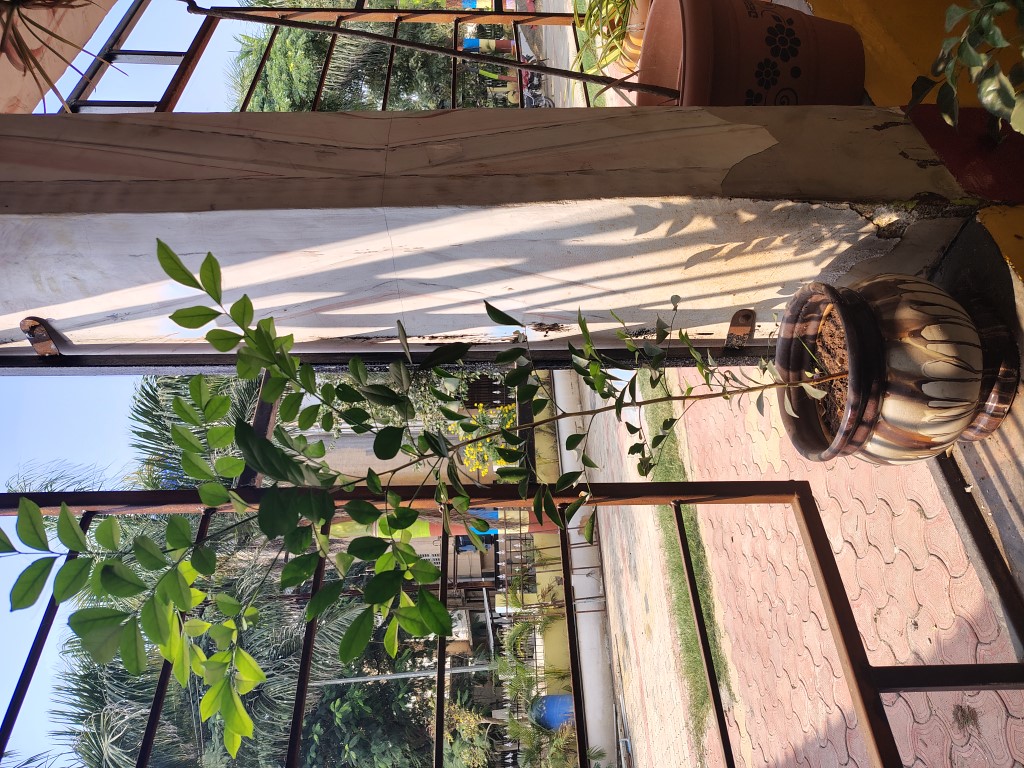Green Campus/Tree Details

कढीपत्ता (Curry Leaf Plant )
परिचय
कढीपत्ता (Murraya koenigii) हा भारत आणि श्रीलंकेतील उष्णकटिबंधीय भागातील मूळचा वनस्पती आहे. हा वनस्पती Rutaceae (लिंबू वर्ग) कुटुंबाचा भाग आहे. भारतीय आणि दक्षिण आशियाई पदार्थांमध्ये त्याच्या सुगंधी पानांसाठी मोठ्या प्रमाणावर लागवड केली जाते.
वनस्पती वर्णन
- शास्त्रीय नाव: Murraya koenigii
- कुटुंब: Rutaceae
- सामान्य नावे: कढीपत्ता, कढीनीम
- मूळ प्रदेश: भारतीय उपखंड
कढीपत्त्याचा झाड हा लहान ते मध्यम आकाराचा वृक्ष आहे जो 4–6 मीटर उंच वाढतो. त्याचा खोड बारीक असून, व्यवस्थित छाटणी केल्यास तो झुडुपासारखा पसरतो.
पानांचे वैशिष्ट्य
कढीपत्त्याची पाने संयुक्त प्रकारची असतात, ज्यात 11–21 लहान पर्णिका असतात. प्रत्येक पर्णिका 2–4 सेमी लांब असते. पाने सुगंधी असतात आणि ती चुरल्यावर अधिक सुगंध दरवळतो.
उपयोग
- स्वयंपाकात:
- भारतीय पदार्थांमध्ये कढीपत्त्याचा वापर मसाल्यात होतो.
- डाळ, भाजी, आणि चटणी यामध्ये फोडणीसाठी वापर केला जातो.
- पदार्थांना चव आणि सुगंध देतो.
- औषधी उपयोग:
- बुरशीविरोधी, जंतुनाशक, आणि सूज कमी करणारे गुणधर्म.
- अँटीऑक्सिडंट्सने समृद्ध असल्यामुळे शरीरातील ऑक्सिडेटिव्ह ताण कमी करण्यास मदत होते.
- पारंपरिक औषधांमध्ये अतिसार, मळमळ, आणि मधुमेहासाठी वापरले जाते.
- इतर उपयोग:
- केसांच्या आरोग्यासाठी कढीपत्त्याचा तेलात वापर केला जातो.
- केसगळती कमी करणे आणि कोंडा रोखण्यासाठी उपयुक्त.
लागवड आणि वाढ
- हवामान: उष्णकटिबंधीय आणि उपोष्णकटिबंधीय हवामानासाठी योग्य.
- प्रकाश: पूर्ण सूर्यप्रकाश किंवा अर्ध-सावली आवश्यक.
- माती: चांगल्या निचऱ्याची आणि सेंद्रिय पदार्थयुक्त माती.
- पाणी: नियमित पाणी द्या, पण माती चिखलाळ होऊ देऊ नका.
प्रसार तंत्र
कढीपत्त्याचे झाड बी किंवा फांदीच्या कोंबांपासून वाढवता येते. बी लागवडीसाठी ताज्या बीजांचा वापर करावा.
सांस्कृतिक महत्त्व
भारतीय संस्कृतीत कढीपत्त्याचे झाड पवित्र मानले जाते आणि घराजवळ लावले जाते. याचा वापर स्वयंपाकात तसेच औषधांमध्ये केला जातो. कढीपत्ता समृद्धी आणि संरक्षणाचे प्रतीक मानले जाते.
देखभाल टिप्स
- थंड हवामानात कुंडीत लावून घराच्या आत ठेवा.
- नियमित छाटणीमुळे झाडाची झुडूपासारखी वाढ होते.
- सेंद्रिय खतांचा वापर केल्याने पानांची चांगली वाढ होते.
Curry Leaf Plant -
Introduction
The Curry Leaf Plant (Murraya koenigii) is a tropical to subtropical plant native to India and Sri Lanka. It belongs to the Rutaceae family, commonly referred to as the citrus family. The plant is widely cultivated for its aromatic leaves, used primarily as a seasoning in Indian and South Asian cuisines.
Botanical Description
- Scientific Name: Murraya koenigii
- Family: Rutaceae
- Common Names: Curry Leaf Tree, Sweet Neem
- Native Region: Indian subcontinent
The curry leaf plant is a small to medium-sized tree that can grow up to 4–6 meters tall. It has a slender trunk and spreads into a bush-like canopy when pruned properly.
Leaf Characteristics
The leaves are pinnate, with 11–21 small leaflets arranged alternately. Each leaflet is ovate and measures about 2–4 cm in length. The leaves are highly aromatic, with a distinctive curry-like fragrance, which intensifies when crushed.
Uses
- Culinary Uses:
- Curry leaves are a staple in Indian and South Asian cuisines.
- Used in tempering (known as tadka or phodni) for dals, curries, and chutneys.
- Adds flavor and aroma to dishes.
- Medicinal Uses:
- Known for their antifungal, antibacterial, and anti-inflammatory properties.
- Rich in antioxidants, which help fight oxidative stress.
- Used in traditional medicine to treat diarrhea, nausea, and diabetes.
- Other Uses:
- The leaves are used in making herbal hair oils, promoting healthy hair and reducing dandruff.
Growing Conditions
- Climate: Thrives in warm, tropical, or subtropical climates.
- Sunlight: Requires full to partial sunlight.
- Soil: Prefers well-drained soil with moderate organic content.
- Watering: Requires regular watering but does not tolerate waterlogged conditions.
Propagation
The curry leaf plant is propagated using seeds or stem cuttings. Seeds have a short viability period, so fresh seeds should be used immediately after harvesting.
Cultural Significance
In Indian culture, the curry leaf plant is considered sacred and often grown near homes for its culinary and medicinal benefits. It is also regarded as a symbol of prosperity and protection.
Care Tips
- Protect from frost in colder climates by growing it in pots indoors.
- Regular pruning helps maintain the plant's size and encourages bushy growth.
- Use organic fertilizers to promote healthy leaf production.
